Asylum Brain Tank Boss
Posted: 08 Nov 2022
12 lines of code lead to an analysis and runthrough of Double Fine's design plans for the Asylum Brain Tank fight with some absolutely fascinating discoveries about the development timeline of said fight.
A while back while combing through Raz’s monolithic script file I found this interesting chunk of code in the function that handles him taking damage. It implements an otherwise unused “Sneeze” damage type, which would make Raz sneeze out his brain.

This code unfortunately doesn’t function at all in the final game - a lot of pieces are missing. For starters the action it tries to run on Raz, “Sneeze Brain”, no longer exists (and no animation seems to exist corresponding to it either).
Second, the entity it tries to spawn, “MC_BrainDart”, no longer exists either. The naming scheme of this entity (where the 2 letter level code precedes it with an underscore) suggests that this is a fairly old entity before they started nesting classes in subdirectories.
MC is of course “Meat Circus”, though one strange naming discrepancy I’ve never been able to figure out is that the brain tank boss section is sometimes categorised under MC. For example, the music for the fight is called “MCTankBoss”.
This does suggest it was still linked to the sequence seen in the final game where Raz becomes a brain - though in the final game it happens during a cutscene. With just the scripts and the brain script itself being missing, it’s difficult to solve what else might be different.
That sequence has always been a bit strange - you defeat the tank, walk up to it, watch a whole cutscene of Raz sneezing his brain out… then have to throw the brain into it. It is a really cool and super fun concept though it has always struck me as a bit oddly paced.
It does seem likely that the final game’s implementation would have been built on the original, so we might be able to gleam information by looking at the existing code.
This variable, for example. It’s set when Raz becomes a brain and the comment somewhat suggests that Brain Raz may have been planned to have more powers at some point? It’s not clear, we can only speculate vaguely.

In terms of powers, this variable just stops most of them from working except for TK, Invis and Shield. Only TK is useful in the sequence but making the others available is a really fun piece of flavour. I still get a kick out of seeing the brain using shield.
Additionally, it seems likely to me that originally Raz’s brainless body was intended to hang around while his brain threw itself around. I can’t prove it but I mean… if this is all happening in gameplay, his body had to do something after the brain got sneezed out, right?
The final game’s brain entity (AS.Characters.BrainRaz) hides the player (and does some other shenanigans) since we see Raz walk off in the cutscene where he sneezes it out.
That aside, I don’t think there’s much else that can be gleamed from the code itself, especially without that original brain script. We’ve got a bit of a secret weapon though - dev documents.
Alongside script and texture sources, there’s another thing that was erroneously shipped in the Steam build in February 2013 - a collection of various types of development documents, spanning across several years of development.
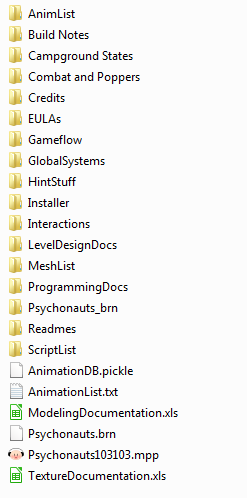
This is the origin of the infamous “Li-Po Backstory Doc” which has (somewhat questionably, given none of it was necessarily intended to be completely canon) filled in the blanks for many fans ever since it was originally shipped by accident.
In fact that document was pretty much the only thing from this build that was preserved until we finally found the manifest and managed to unearth the rest.
I do want to do a thread (or possibly threads, plural, given there’s a lot of ground to cover here) giving an overview of these but there’s two documents in particular here that are relevant to us investigating the history of this boss battle.
Both are in the “LevelDesignDocs” folder - ASBrainTankDesign.doc, ASRU.txt. Two of these files document seperate concepts for this fight, with neither quite lining up with what we got in the final game.
These are planning documents so we don’t know if the concepts therein were actually implemented ingame at any point, but they do regardless lay out what DF’s tentative plans for this sequence actually were, used as the groundwork for later revisions.
It’s usually pretty difficult to date these documents, we have no chance at all of dating ASRU.txt since it’s just text, but doc files have a pretty gratuitous amount of metadata so we can approximately date ASBrainTankDesign.doc
The .doc file metadata dates ASBrainTankDesign as created the 9th of March 2004 at 5:41pm, revised 26 times and last saved on the 16th March 2004 at 3:20pm. (Times converted to PST to match Double Fine’s time. GMT times shown in image below.)

I don’t know how accurate that creation date is, it could be possible it dates earlier than that and got overwritten by shenanigans, especially since the classname of that brain entity would date the brain sneezing stuff earlier than 2004 if my timeframes are right…
…but it is also possible that, given the couple of things we have that seem to tie the brain tank and sneezing to MC (Meat Circus), and the fact this file is explicitly tied to Asylum instead, there is an earlier version of this battle we have basically no info about anywhere.
Which wouldn’t be unusual, because there is a lot of stuff like that when it comes to this game’s development. Concepts, mechanics and ideas we have just the slightest hints of, vague mentions and one-offs, and no other info. This is just another on the pile.
So, there’s a chance these docs may not directly relate to the original thread subject, but stuff like that hasn’t stopped me from going on tangents before so consider this a small bite sized preview of the future document analysis threads.
We’ll start this brief analysis with the .doc. ASRU.txt describes a fightcloser to that of the final game’s so while we can’t date it we can still assume that it’s the later revision. It starts close to the final game, but apparently they didn’t get to have their TK rock scene.
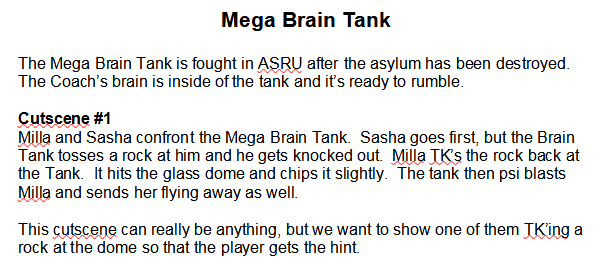
It goes on to set the scene. Again, it does not immediately sound too far off but there’s a clear difference in the arena design. Instead of the final design where the boss is central and everything revolves (ha) around it, the boss is situated on the arena’s edge.

I visualise this being intended to be similar to the arena in which you fight the blueprint brain tank - a big circular arena with a bunch of stuff around so you can hide from its attacks. Main difference being that here your foe is bigger and fixed in place outside the arena.
Notably, it makes zero mention of the tank shielding itself with debris as happens in the final game - this makes sense. The final game’s debris shield is very much reliant on the player circling around the boss which obviously isn’t gonna happen here. Already, massive deviations
So, that’s how the fight is set up. How does it play, well, the title alone of the next section is quite telling - Stage #1. A multi-stage fight! In the final game you hit the boss 3 times but its behaviour barely changes. The timings and speeds of its abilities change. That’s it.

According to the doc, the first phase of the fight played very close to the final game’s without the ring shield. The boss throws rocks at you, and you gotta do the same to it 3 times. There’s some important differences though.
In the final fight, the rocks you throw at the boss are just kinda laying around. In this early version, the boss threw rocks and then you had to pick up the rocks it threw and throw them back. If you let too many rocks pile up, some of them explode.
In the final game, once you hit the boss with 3 rocks, you basically win. Yeah there’s the fakeout with the sneezing powder and needing to toss your brain into the tank but the fight is won at that point. Not here - into stage 2!
Stage 2 is… well it’s nothing to write home about but it is interesting. It plays similar to stage 1 but now the tank can PSI-blast you. It protects its exposed brain with a shield but needs to drop it to attack. That’s Raz’s window to strike, and he can do it one of 3 ways.
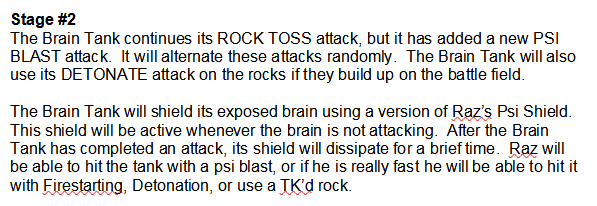
Simple enough though there’s a bit of an elephant in the room here for the observant - the mention of “Detonation” is one of the means Raz has for hurting the tank. To try and keep it brief, detonation was a scrapped ability that likely got merged into firestarting.
Or it might’ve always been part of firestarting but regarded as its own thing when you got the firestarting explosion upgrade because that was originally a triggered ability?? Remember when I mentioned how we know of a bunch of stuff only very vaguely?
Anyway here’s the ability icon for detonation. Moving on.
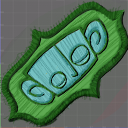
Stage 3 is where things start getting very interesting. This is the equivalent to the final game’s Raz brain stage but this document presents 2 possible choices for how they could choose to design this sequence. The “Puzzle” option is essentially identical to the final approach.
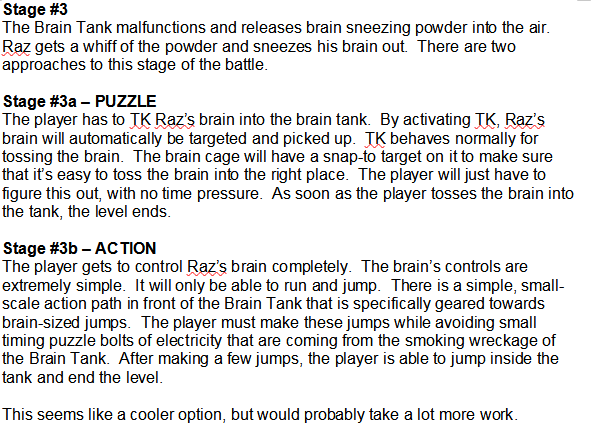
The “Action” option on the other hand seems like it was a lot more ambitious (and harder to implement!). If they had chosen this option, you’d control the brain like a mini Raz that can only run and jump. There’d be a whole brain-sized obstacle course for you to run through.
Cute, maybe a little goofy, certainly as the doc suggests it’s much more of a pain to implement than the puzzle solution. I do wonder if they ever attempted this implementation before deciding their time was too limited and ditching it. No evidence to suggest it unfortunately.
So, while this is almost certainly not the brain sequence we were looking for, it does show at least that this sequence (and this boss as a whole) has some history.
While this is the end of the fight, we’re not done with this document. There’s some more to go because games are complex beasts and generally it saves a lot of pain if you plan things thoroughly, so that’s what they did.
This section for example makes it clear what interactions each of Raz’s PSI powers would have during the fight and what purpose, if any, they’d serve. There’s not much written here that wasn’t already explained but keep the Levitation and Clairvoyance mentions in mind for later.
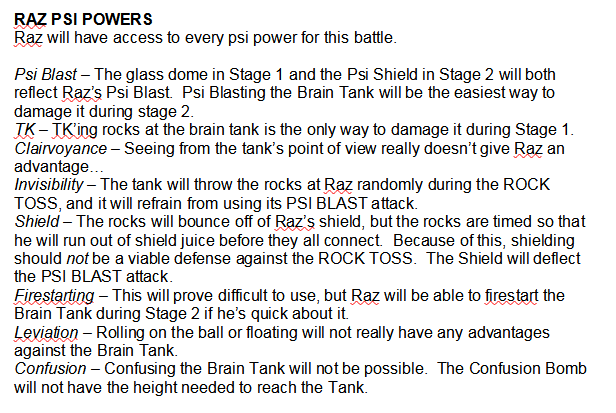
It is also notable to me that “Detonation” is not specified here as an individual ability, so either there was a change made here or “Detonation” did indeed at this point describe the component of the firestarting rather than being its own thing.
Finally, we have descriptions detailing the specifics of each of the brain tank’s various means of attacking. While these were mentioned earlier, this section goes into details on what exactly these attacks would entail, giving us some good info about the dynamics of the fight.

First off, it makes it clear that unlike the final game, this earlier boss iteration would toss 4 rocks in quick succession and also reiterates some of the information in the previous section about how this works with Raz’s abilities and how the timing should be tuned.
This would probably be a bit of a pain in the claustrophobic arena of the final game but given the extra space in this arena thanks to the tank being on the edge rather than in the arena itself it makes sense here.
This would probably be a bit of a pain in the claustrophobic arena of the final game but given the extra space in this arena thanks to the tank being on the edge rather than in the arena itself it makes sense here.
The description of the PSI blast is very interesting to me. It describes it as being like “the old brain tank”, but the way it describes it sounds almost exactly like how the blueprint brain tank’s PSI blast works. This raises a question - what is “the old brain tank”?
Could this just be how they chose to refer to the blueprint brain tank? Or is it perhaps one of the few bits of info we’ve got on an older version of this fight, documented almost nowhere? We don’t know. It’s a fascinating thing to consider though. 4 words raising such a question.
To finish, the doc just clarifies that the rocks thrown by the tank should drop health and ammo when destroyed to make sure Raz always has the supplies he needs. Fairly normal boss design stuff. That concludes the information in ASBrainTankDesign.doc, what’s the overall takeaway?
Well, this is one of the things I love most about this kind of archaeology. You can so clearly see the similarities with the final iteration, the DNA is abundant. Yet, this fight is still very fundamentally different.
You can compare and contrast this old iteration with the final. You can pinpoint which elements were trimmed, changed, added and it encourages you to consider why those changes were made. More of this type of analysis will be possible when we check out ASRU.txt.
As for the fight itself, well, it does seem like it was more ambitious than the final game. In my opinion this iteration may have come across as slightly less dynamic. I kind of like the 360 circling nature of the final game’s fight.
So, ASRU.txt. This file is… a bit of a trip. I will be honest, I made a mistake. Because these threads are so stream of consciousness I only did a quick skim to figure out where to start. I did not fully digest or think about all the information.
I’m sorry for that because that does mean some of this thread now contains potential misinformation but it is a real shock so at least it adds some dramatic flair, I suppose. Let’s get started.
So, from a glance you might assume that ASRU.txt is earlier. It’s a plain text file instead of a fancy doc file, and seems a bit rougher. But take a look at this. The first section of this file nearly perfectly describes the final iteration of the fight!
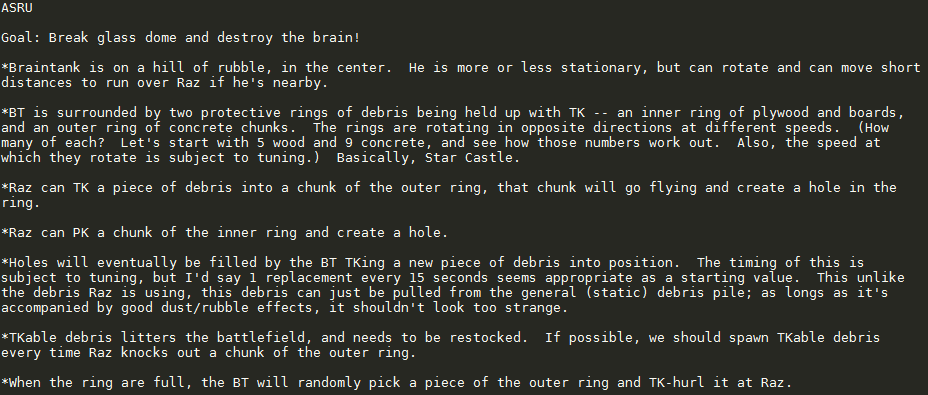
There are of course minor differences here and there. Values tweaked, details ironed out, but initially, it’s basically the same fight.
After this though, we have a couple descriptions telling us how some of Raz’s powers could be utilised in the fight and hey! Look! Clairvoyance and levitation! Two things that were basically useless in the other iteration of the fight have some use here.

Hell, the hazard immunity of the lev ball didn’t get any actual use in the final game period. This proves that they were thinking about it, at least. I guess there was probably just no room for compelling puzzles or scenarios that utilised it.
It goes without saying, neither of these apply to the final version of the fight. You can’t get a bird’s eye view of the arena, and the brain tank certainly doesn’t throw any barrels. There is toxic waste on the floor around the arena though.
Though, funny enough, this fight is still one of the only places in the game where the lev ball hazard immunity does something because it does indeed protect you from the toxic waste that’s on the floor of the arena in the final game.
More stuff that’s not different to the final version. The brain tank is immune to everything of course, and while it doesn’t pick him up in the final game, it does swat him away. But hey! That’s different, it’s got the PSI blast still. That’s cool.

The document compares the PSI blast to the cannon in Lungfishopolis, and Raz’s own PSI blast. Interesting that those were the comparisons chosen but when I first read this I thought nothing of it. Maybe you can already guess where this may be going, though.
We get a general rundown and overview of the entire fight’s concept. Again, it’s almost the same but here the file mentions that this version of the fight would have changed with each hit on the tank, with it adapting to Raz’s strategy.

Again, the values of the tank’s attacks do get tuned and tweaked with each hit in the final game, but nothing particularly obvious actually changes. In this version though…
This is a super cool progression. The first hit starts normal but then the tank starts firing off blasts at you when it can. When you hit it again, it gets smarter. It’ll wait for you to try and throw something at it before blasting you to interrupt your TK.

Finally, it’d start shielding with the right timing to defend against your attacks and you’d need to throw two rocks in quick succession to throw it off and finally land the last hit.
I absolutely adore this progression and I’m a little disappointed we didn’t get to see it play out. I really love the concept they wanted to get across of the tank learning and adapting - it’s a brain tank! That’s one of the advantages of it having a brain! It’s cool!
So, how did this fight end? How does the brain sequence compare in this version? Well, let’s take a look here…
So, you finally smash open the dome. The tank deactivates. Very much like the final game. So, you walk up to it and… it… tosses a sneezing powder grenade… and Raz sneezes his brain out… and… oh. Oh dear. That doesn’t sound like a cutscene.

This is where it clicked. This file - this file that describes a version of this fight closer to that of the final game despite being so rough. It is not the newer file. This is the older version of the fight.
This is “the old brain tank”. This is the fight that the other document was referring to. And this fight has the ingame sneezing powder, and it would’ve probably used the “Sneeze” damage type.
So. This iteration came first. Then it was redesigned into the version with the static tank that was covered before. But that redesign was not the version used in the game, the old design was used. The final version is different to the one described here of course, but…
It is undeniable this iteration of the fight still, all the core concepts are the same.
This raises so many questions about how exactly the timeline goes. That 2004 date on the other file suddenly makes a bit more sense. I’m not sure they’d have even had time to build that version by that point.
Did the version we got ingame come before or after the proposed redesign? Perhaps they built out this iteration, proposed the redesign and then went back to the original to save time, making tweaks and changes.
I mean, the way the brain sequence works in the final game is basically exactly as described in the “Puzzle” option for the redesign’s version of the fight. But is that because it was carried over from the original, or was it “backported” from the redesign?
It’s incredible how with the context of just a couple chunks of code and two documents, this one boss fight that, I’ll admit, is fairly overshadowed by the level following it, has some of the most interesting development quirks we’ve seen so far.
Unfortunately, we don’t have any other kind of trail to give us more information. We have a playtest guide for a very old version of Asylum (2002), but the build it was written for stops before this fight would take place.
And so, we are left here. We’ve ended up with more questions than answers. We… maybe figured out some of the mystery behind the “Sneeze” damage type (remember when this thread was about that?) but besides that we’ve just got more stuff to ponder and speculate on.
And NONE of this resolves the naming discrepancy where elements of this fight have been somewhat inexplicably filed under Meat Circus in some places! I don’t believe at all that this fight was ever in Meat Circus
Maybe though originally ASRU was technically considered part of MC? MC did get shuffled around a bit, maybe that was part of it?
Code for the tank’s scrapped PSI blast is still present here, but no other code for its adaptive changes it seems. Mind you, I don’t reckon it’d be the hardest thing to restore… maybe not right now.
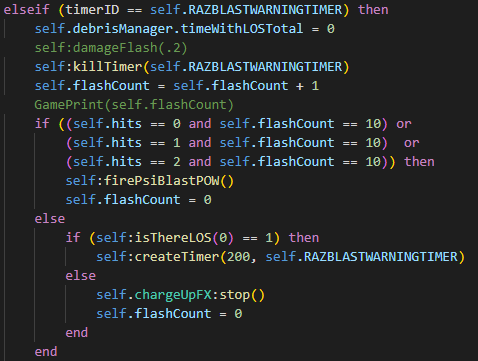
The real challenge would be trying to mod in the implementation of the redesigned fight that we never saw. That’d be a fun project. It is all laid out in that document after all. Tools aren’t quite there to modify the level to that extent yet unfortunately but perhaps some day.
So uh, all that stuff I said about comparing revisions to see what changed and consider why? Yeah that’s a bit more complicated in this scenario where we’re once again lost as to what the timeline was but hey, still fun.
I don’t think I have much more to say on the brain tank, nor the “Sneeze” damage type. This was a really wild ride and I did not expect it to turn out to be so bizarre, I thought this’d be a fairly straightforward runthrough.
Luckily I don’t think there’ll be any similar surprises when I get around to examining the other documents. Maybe. Who knows at this point?